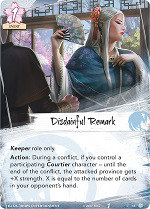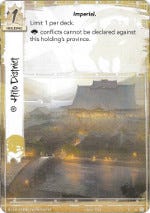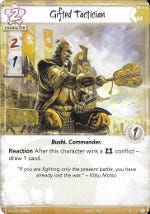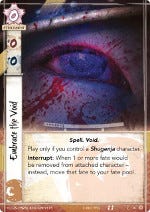Imperial Packs – Tears of Amaterasu

Tears of Amaterasu, the first dynasty pack in the Imperial cycle, releases November 9th. Let’s have a look and see what it holds.
Crab

This holding is limited to 1 per deck. As an action, you can give an opponent 1 fate and take control of one of their attachments. Crab don’t have an in-clan way to deal with attachments, so this does add something. The 1 per deck limit it the only way to have a unique limitation on holdings, as they come into play immediately, but it makes this card very unreliable. In addition, the cost for the effect is a shift of 1 fate, so effectively 2 fate. This means the attachment needs to be worth it.
Unfortunately, this combination of high cost and unreliability along with the need for a good target to be effective really hampers this card. Rebuild helps out a bit, if your opponent drops a worthwhile attachment, a previously discarded Karada District can be brought back into play. In the old game we did have the Ancestral Swords of the various clans, if these powerful attachments were to be printed again, this would significantly improve the value of this holding. Currently, I don’t think Karada District is worth it due to how unreliable it is, but it wouldn’t take much for this to be an important tool in the Crab’s arsenal.

The Staunch Hida is a 2 cost Bushi with 2 military, – political, and 1 glory. She has a Reaction that allows you to resolve the ring if you win a conflict on the defense. The 2 cost for 2 skill is decent and the ability is nice, but doesn’t help you win that conflict. At 2 cost, she is always vulnerable Assassination. The other 2 cost Crab characters (Hiruma Yōjimbō, Shrewd Yasuki, and Vanguard Warrior) are all good but do have limitations. The Staunch Hida is no different, the — political means this is only going to work in military conflicts, so it is only going to be relevant in 1 of the 4 possible conflicts. Despite the issues, the Staunch Hida will make a nice addition to the defensive Crab dishonor deck.
Crane

This is a 1 cost event that is keeper only, that means currently Crane cannot play it and it can only be splashed by clans with a keeper role. You need to have a Courtier to play it, and it increases the province strength of the attacked province by the number of cards in your opponent’s hand. Although hand size can vary, it is not unreasonable to expect this to be at least a +4 to the province strength. This isn’t going to stop your opponent from claiming the ring, but it is likely to save the province. Your opponent is going to have to play at least two cards to account for each Disdainful Remark. At only 1 influence it makes as nice addition to any deck splashing Crane. Currently only Lion and Phoenix have the required Courtiers and a keeper role.

This is a 3 cost Courtier with 1 Military skill, 3 political skill, and 2 glory. The Representative has an action that moves them from the conflict back home. The stats are similar to that of Kakita Asami but are not very exciting. The ability allows the Representative to assign to a conflict, play For Shame! or Outwit and then get out of the conflict ready to assign to a new conflict. This reuse doesn’t allow the character contribute their skill twice but can be very effective.

This 0 cost attachment gives +0 military and +1 political skill. The attached characters gains the Crane clan symbol and Duelist trait. This is the first of the seals we have seen. A 0 cost attachment for a point of political skill is efficient if not necessarily a worthwhile investment. While the fate to skill ratio is great, it still costs a conflict card and a deck slot. The Crane clan symbol doesn’t mean much right now. The Duelist trait doesn’t yet have a use, but we have seen a spoiled card called Test of Skill which has a minor bonus if you have a Duelist character in play. At only one influence it is an easy splash. This may be a way for players to make story-based actions within the game. For example, a Crane player who is using the Crab Hiruma Ambusher could have that ambusher ‘swear fealty’ to the Crane. Alternatively, a Dragon player could have Togashi Initiate join the Crane. If this were something to happen in a final, the story team could design to run with it and make a big change!
Dragon

This Courtier is a 4 cost character with 2 military, 4 politics, and 2 glory. This is Dragon’s second Courtier along with the excellent Kitsuki Investigator. The 4 political skill is important, this is a number that will allow Yaruma to solo provinces and effectively use Outwit. He has Courtesy, so when he leaves play, you get a fate back. As the character is unique, only one copy can be in play and additional copies are going to give him more fate. This makes the Courtesy keyword a little less useful, especially on a high-cost character, as it is less likely to trigger.
He has a reaction when entering play to turn an unbroken province card face down allowing an ‘on reveal’ province a second attempt. The ability is, unfortunately, too situational to be worth relying on. Your opponent needs to have attacked an ‘on reveal’ province but not broken that province. Then, Yaruma needs to appear. As Yaruma is unique, if you already have Yaruma in play then you won’t be able to play the second copy.
Yaruma cannot have poison attachments, currently this only stops the Scorpion card Fiery Madness. Mechanically this isn’t a big deal as the Scorpion are only going to find another target. This is actually very relevant for the story, according to the Wikia for the old story his son was kidnapped by the Scorpion and raised as Bayushi Tokai. The Scorpion maneuvered Tokai into place as the Emperor’s food taster. As the Kitsuki are immune to poison, when the Scorpion poisoned the Emperor’s food, Tokai who inherited his father’s immunity showed no ill effects.
Unfortunately, Yaruma is a little too disjointed, his ability and Courtesy are unlikely to be useful, so really it is whether a 2/4 for 4 fate is worthwhile. This might help Dragon stretch to a Courtier deck, but he is likely to be removed as soon as another option comes along.

This is a 1 cost unique attachment that gives +0 military and +1 politics. As an action, you can bow the attachments to move 1 fate from an unclaimed ring to another unclaimed ring. It is quite typical for there to be 2 fate spread across two rings from turn 2 onward. The Masterpiece allows for a two options: First, to move fate onto the ring you already want and then declare that ring. Second, to move fate away from the ring your opponent wants.
This can be especially relevant when you are using abilities such as Togashi Initiate, Kitsuki Investigator, or Enlightened Warrior which require moving fate onto rings. This also helps scoop up fate that will accumulate while the yet to be released The Stone of Sorrows remains in play or with the event Written in the Stars. It is likely this card will pay for itself, although, as it does cost a conflict card you would hope it will do more than pay for itself. This is a potential piece is a fate dominance game that the Dragon are clearly setting up for. Just like every other Dragon card it is 2 influence.
Lion

This is a seeker only event that costs 0 fate. As Lion currently have a keeper role, Lion cannot play Time For War. As a reaction to losing a political conflict, you attach a Weapon from your hand or discard pile, with 3 or lower cost to a Bushi for free. There are currently four weapons in the card pool, Ancestral Daishō, Fine Katana, Honored Blade, and Jade Tetsubō. Those are 1, 0, 1, and 2 fate respectively none of which fully take advantage of the 3 cost discount. Even though this is only 1 influence, it is not yet the time for Time for War. As previously mentioned, the Ancestral Swords are a potential option which would significantly improve the value of this action. Currently, Dragon, Crane, and Scorpion are the clans with the seeker role, none of which are particularly prone to losing political conflicts. This looks like this is a card for the future.

This Imperial holding is limited to 1 per deck. Political conflicts cannot be declared against this province. Hopefully, there is some sort of combo with an as of yet unreleased card, but right now I have no idea what this card is for. You have no control over which province this deck will pop up in. If it turns up in a broken province, your opponent cannot attack it. If it turns up in an unbroken province, your opponent can attack any of the other provinces with a political conflict instead. I just don’t get it.

This Bushi character costs 2 fate and has 2 military, 1 politics, and 1 glory. As a reaction to winning a military conflict that this character is involved in, draw a card. Lion love cheap Bushi, it clears the path for Staging Ground and is another body for cards like Yōjin no Shiro and Honored General. Getting to draw a card after winning is great and is an important addition to the clan who like to bid low and have limited card draw options. The Gifted Tactician is comparable in many ways to the Akodo Gunsō but lacks the province refill. Where the Gunso’s Pride can be a liability, the Tactician suffers no ill effects for losing making it a solid target for 1 additional fate.
Phoenix

This is a 0 cost attachment that you can only play if you control a Shugenja. It gives +0 military and +0 political. As an Interrupt when 1 or more fate is being removed from the attached character you can move that to your fate pool. The easiest way to play this is to drop it on a character that has the largest amount of fate and get a slow drip of fate. As interrupts are actions, they are limited to once per turn so you can’t use the ring of void to get one and the end of turn to get another unless you put two Embrace the Void on the character. The effect does say when 1 or more fate is removed, so if you can arrange for multiple fate to leave at once, you can claim it all. In this case, it is preferable to play Embrace the Void on your opponent’s character rather than your own. If that character is then discarded, for example, due to an Assassination, you would get all the fate. Similarly, this works very well with the Crab card Jade Tetsubō sending all the fate back to your pool rather than your opponent’s pool.

This 5 cost Shugenja has 3 military, 4 political, and 3 glory. Kaede is immune to opponent’s ring effects. When Kaede is attacking the ring gains the void element and if you win you get to resolve all the ring types rather than having to choose. The Phoenix clan champion Shiba Tsukune is considered to be one of the best champions, but Kaede may give her a run for her money.
As she cannot be targetted by opponents ring effects, she cannot be bowed with water, dishonored with fire, or have her fate removed with void. Once she is honored she will be incredibly hard to dishonor. When she attacks you get ring of void as an extra ring. This powers up Isawa Atsuko even in battles where ring of void wasn’t originally declared. She also gets to resolve all rings, so if you declared fire you get to resolve fire and void. In addition, if you drop in a Seeker of Knowledge as well you can resolve fire, void, and air.
As Kaede just has text rather than actions, her ability can be used again. Moving her into the second conflict with an action such as Favorable Ground, even while bowed, will let you resolve the ring of void effect a second time along with whatever ring was declared.
Scorpion

This is a 1 cost conflict character with – military and 1 politics. This character is a Peasant and a Shinobi. As a reaction to entering play, you can look at an opponent’s hand. 1 cost for a character is great, an extra character out of nowhere can surprise your opponent and declare an attack they were not expecting. Unfortunately, this character is – military which means you’re not going to be declaring a military attack with it. As Scorpion are strong in political, it is unlikely they would need the support to declare a political attack.
The entering-play ability is fantastic, unlike the Kitsuki Investigator you don’t get to discard a card, but you do get to see your opponent’s hand and can play a perfect game. As FFG do not allow note taking, this is going to be a high skill card benefiting those who can remember all the cards they saw. In this game, hand sizes can get very high, so you may need to remember a dozen or more cards. At only 1 influence, this card may actually be better as a splash for a military-focused clan who can get more out of the 1 political skill than the Scorpion can.

This 1 cost event allows you to return your attacking Shinobi characters home. This allows you to attack as a feint, leaving any defending characters to bow out at the end of the conflict while your Shinobi are ready to attack in the next conflict. This may eventually be worthwhile once the Scorpion have enough Shinobi to have a full deck, but right now there are less than a handful of Shinobi cards. Including Meek Informant, there are 4 along with Adept of Shadows, Shosuro Actress, and Shosuro Miyako. At the moment Smoke and Mirrors goes straight into the binder, but it promises a fun Shinobi deck in the future.
Unicorn

This is the first holding for the Unicorn. It has +1 province strength and can be sacrificed to give each player 2 fate or 2 honor. The province then refills face, so although the ability benefits both players, it doesn’t penalize the Unicorn player. This is a bit of a strange addition for the Unicorn as it, in theory, supports an aggressive honor running strategy, something the rest of the Unicorn card pool does not promote. Alternatively, the honor gain can be used to pull back from a dishonor loss, allowing more card draw. In both cases, you’re hoping the honor gain will help you more than it will your opponent.
The other side of this is the extra Fate, everyone likes more Fate so getting an advantage out of this is going to be tricky. During the dynasty phase you can choose to let your opponent pass first, this will allow you to use the extra fate during the dynasty phase while your opponent will have to wait. Alternatively, it can be used as late as possible, only when you have an action you want to use, for example, Cavalry Reserves. This will retain the fate for the most advantageous time for you and not your opponent, it will get the least benefit out of the face-up refill though. Arguably, if this card didn’t have any honor or fate gain and only sacrificed to refill face up it would still be playable as it tightens up the dynasty deck for Unicorn. This will be 3 in every Unicorn deck even if it will take a while to work out how best to use it. It will also offer a strong incentive for Unicorn to splash Crab to get access to Rebuild.

This 3 cost Bushi has 2 military, 2 political, and 1 glory. Despite horse in the picture, this character does not have the Cavalry trait. While attacking, each other character that has fate on it does not count its skill for the resolution of the conflict. Any card that changes the rules of the game is worth paying attention to. The stat line of 2 military and 2 political for 3 fate is poor but at least it is Assassination proof and is useful in either conflict type. That the ability only works on the attack means your opponent gets to see what is going on and choose who to declare. It also means you cannot neuter a defense with just 1 character. The ability works nicely with Charge and Cavalry Reserves where characters are coming in without Fate anyway. It also provides a fun Charge! target which could make a big difference as a surprise arrival. The Magistrate can be sent home and unfortunately without the Cavalry trait, cannot be moved in again with the stronghold.
Neutral

The Finger of Jade is a 1 cost attachment with +0 military and +0 political. When a card ability targets the attached character you can sacrifice the Finger to cancel the effects. For decks that have a wide board this isn’t going to offer much, if your opponent can choose from multiple targets they will just choose another target. Decks that have a tall board, ones like Dragon that invest in a ‘super unit’ are going to love this card. Decks like Phoenix who have key characters that they want to keep safe, such as Isawa Kaede or Shiba Tsukune, are also going to like this. The Jade Finger provides amazing protection from kill actions like Noble Sacrifice, and I Can Swim. It also prevents bow and send home actions that might turn the tide of a conflict. Notably, due to the timing this will not stop cards like Way of the Crab or Court Games which have targetting as part of the effect rather than the cost.

Goblin Sneak is a 2 cost conflict character with 1 military, – political, and 0 glory. This is the first Neutral conflict character we’ve seen, so it is worth remembering that there is a limit of 10 conflict characters in the conflict deck. When the Sneak comes into play, he takes 1 fate from your opponent’s pool and places it on itself. The cost of 2 fate for a 1 military and – political character is poor, but you do get to remove 1 of your opponents fate and add it to the Goblin Sneak. If your opponent is on 1 fate, bringing them down to 0 significantly reduces the number of conflict cards they can play. If your Phoenix opponent is on 2 fate and you are about to win an unopposed conflict, dropping this sneak into play will stop them playing Display of Power (also remember that during a conflict when you play a conflict character you can choose to play them into the conflict or at home).
For those new to the game, the Shadowlands trait may not mean a lot but players of the old game are super excited to see this trait on a card. The Shadowlands is the area to the south of the Crab wall. That area is corrupted by evil, it is the home of unnatural monsters that want nothing more than to corrupt and destroy the Samurai of Rokugan. There are some players who will never play Shadowlands cards in their decks no matter how good they are, for fear the story team will see and decide that clan is somehow corrupt. There are also some players who get as many Shadowlands cards into their deck as they can, either because they love the bad guys or because they feel it will make the story more exciting.

This is a neutral seeker only fire province with 3 province strength. During conflicts at this province, each player cannot spend fate from their fate pools. When it is attacked the first time, it will come as somewhat of a surprise to the attack, so it is possible they might be expecting to spend some fate to take the province. On the other hand, it will also come as a surprise for the defender as you have no control over which province your opponent attacks (unless it is the last one). As the province strength is 3 rather than the normal 4, it almost comes as a relief to the opponent that they don’t have to spend fate. On subsequent attacks the attack will know they need to spend fate before the attack and can account for the province, essentially negating it. It competes against Night Raid and Meditations on the Tao both of which are more reliable.

This void province is Keeper only. It has 4 province strength and has a reaction to gain fate equal to the number of attackers. The reaction is similar to Night Raid which discards cards equal to the number of attacks. Night Raid has mixed popularity as it will often just discard 1 card. As a void province Tears of Amaterasu competes with Pilgrimage and Shameful Display. Shameful is considered by many to be the best province in the game. If this was a Seeker province, Tears could compete to be the second province included, but with such high standards, it is unlikely to be played.
Phoenix look like the big winners out of this pack. Isawa Kaede is probably one of the best characters out there. Both the Finger of Jade and Goblin Sneak are good neutral cards that will see play.
Listen to us break down the cards in our most recent episode of Imperial Advisor.

7 Replies to “Imperial Packs – Tears of Amaterasu”
You can choose to not resolve a ring after winning a conflict with Isawa Kaede in it? The wording makes me think I would be forced to resolve the void ring even if only my characters have fate on them.
When there are multiple elements to a ring it actually adds an extra step. The steps would be
a) Choose whether to resolve the ring or not
b) Choose which of the elements on the ring to resolve.
Kaede would replace the b) step so you would still get to choose whether to resolve the ring or not.
So you could choose between resolving the two effects or none, but not just one of them?
Yup.
I think you are too harsh on the Crab holding. It definitely has it use in the current crab decks.
You might be right. The rest of the team are a lot more positive about it, especially in conjunction with Rebuild. As I’m a Dragon player, when I first saw this I was immediately alarmed. Ever since I’ve been talking myself out of worrying about it by reassuring myself that no one will play it so it’s fine 🙂
Near the end of the second episode of the Honorable Mention podcast, Brad Emon and the team discussed the province Blood of Onnotangu. They had some pretty cool ideas on how to run a deck that didn’t use fate to take advantage of this, especially with the Scorpion holdings City of Lies. Worth checking out http://honorablemention.libsyn.com/episode-2-magical-samurai-with-guest-brad-emon